Language Teaching Methods Techniques and Principles[FLED 303] Contemporary


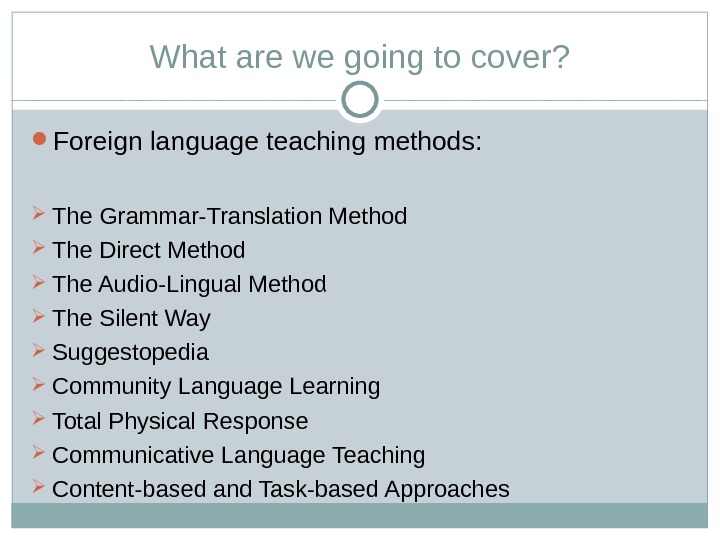

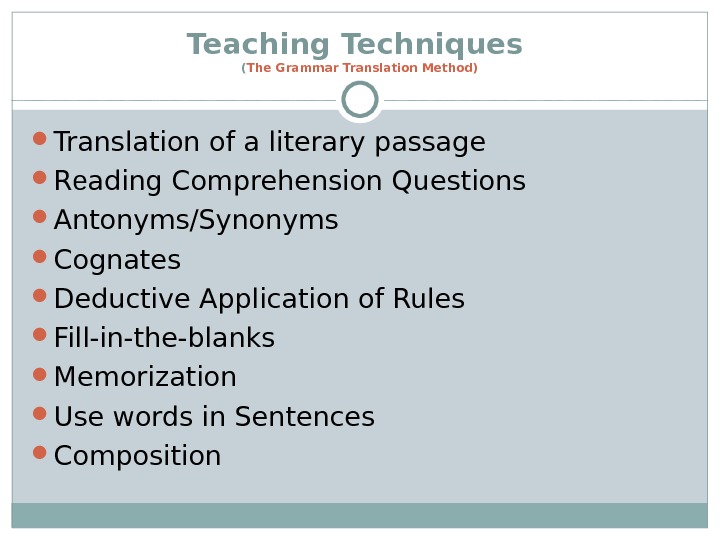






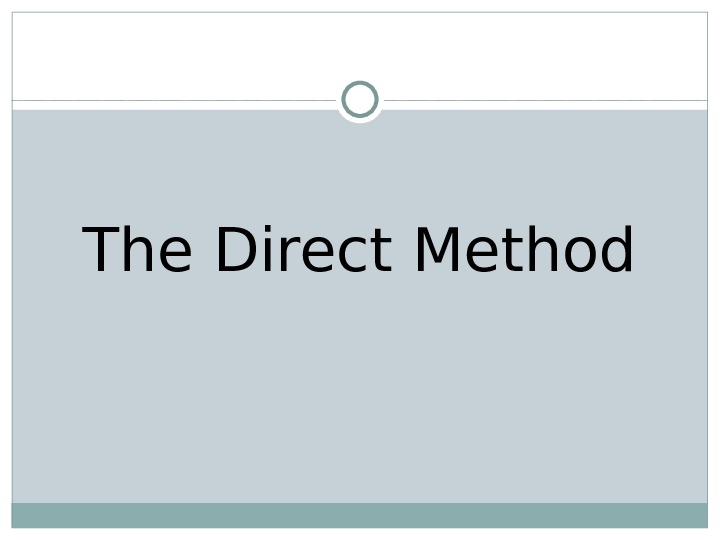

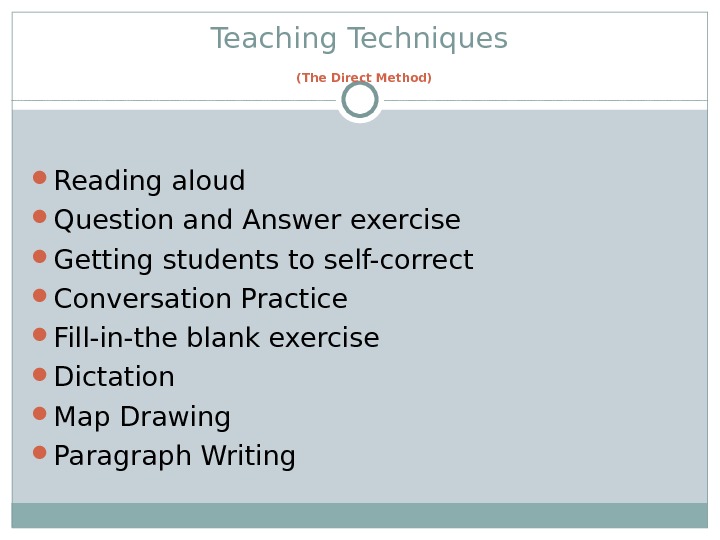

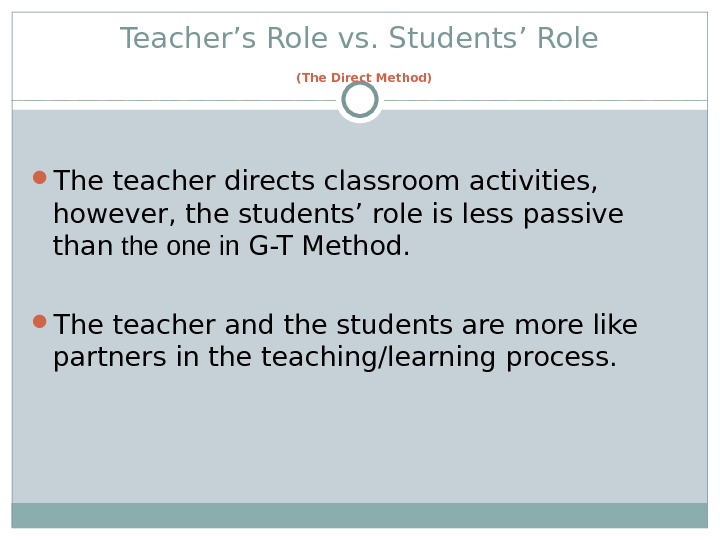



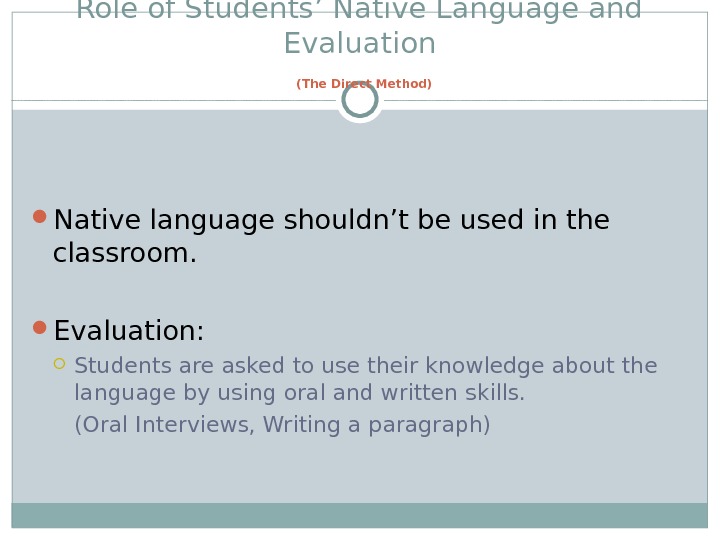





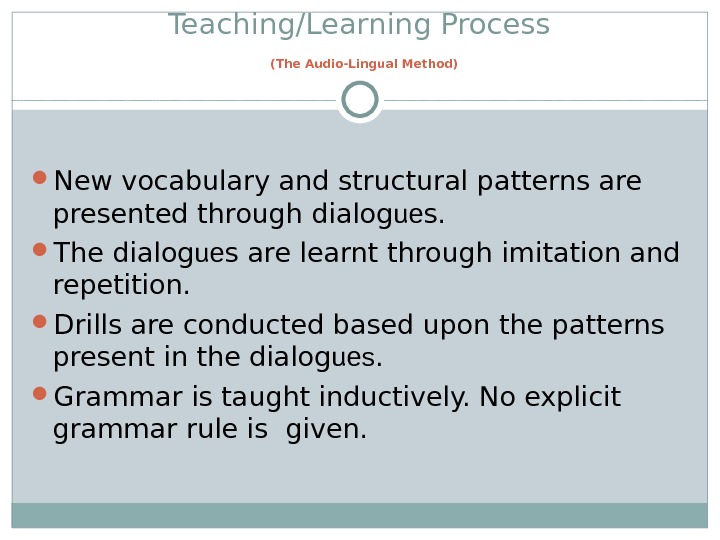


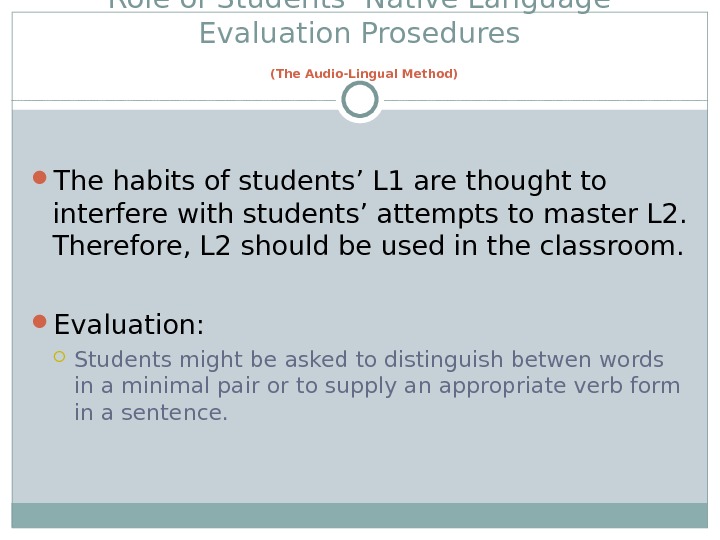

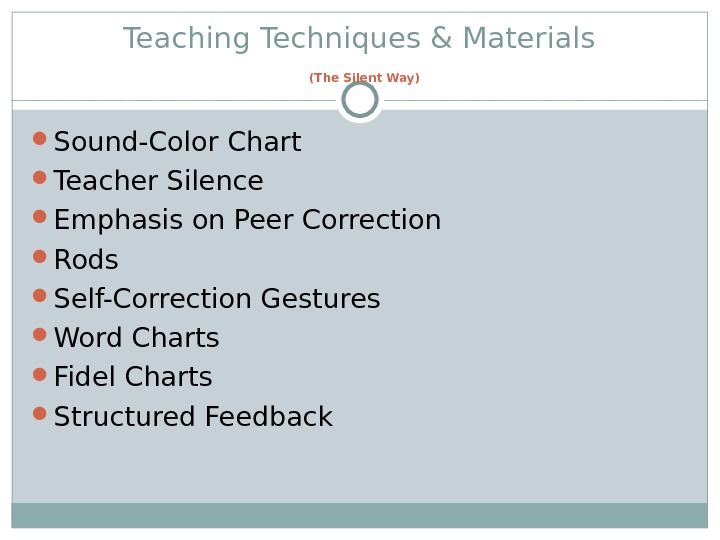


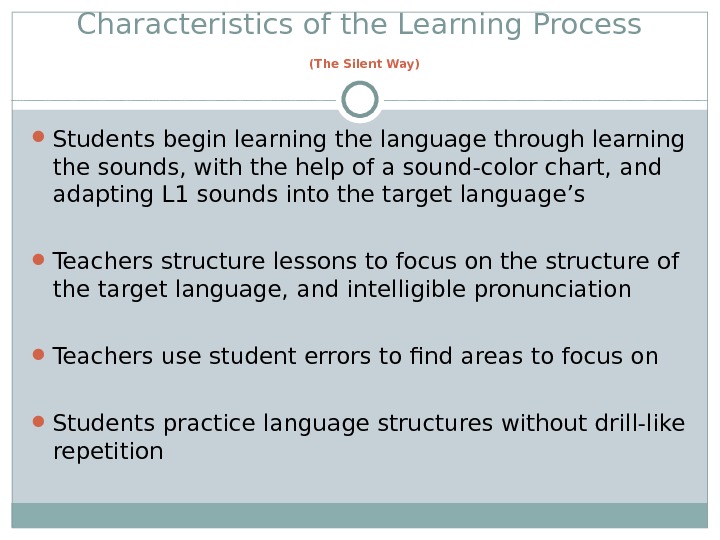


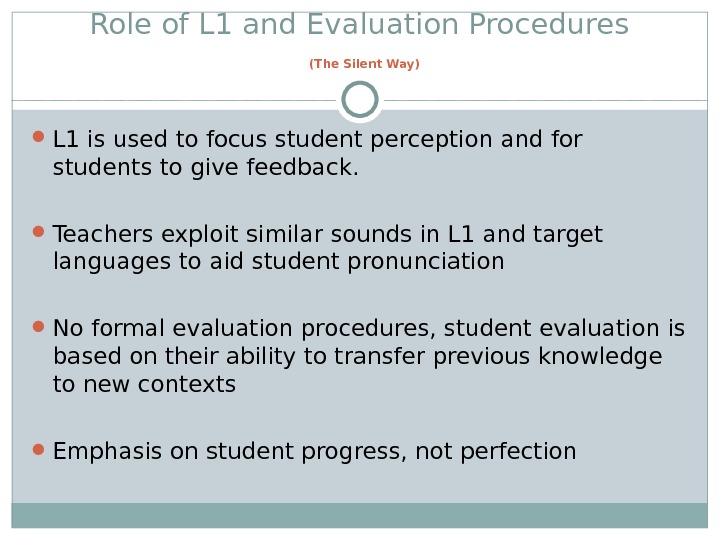
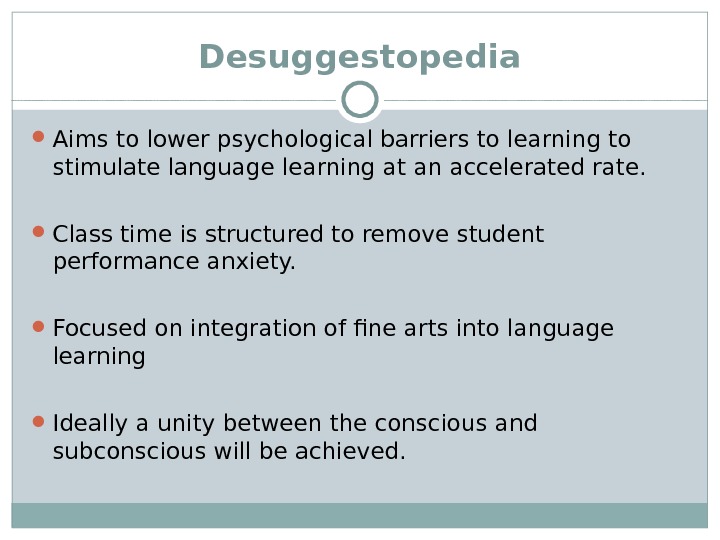
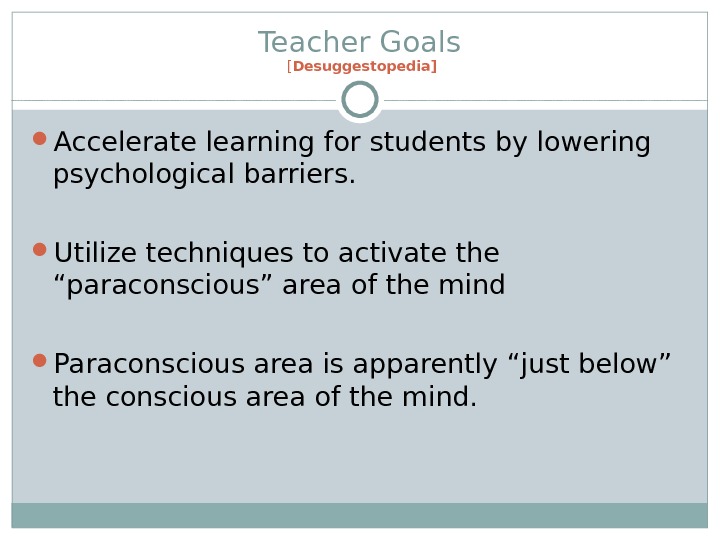





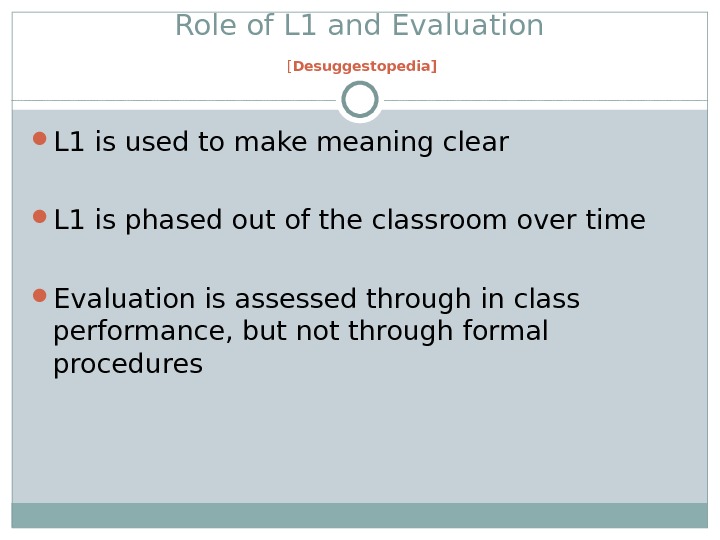

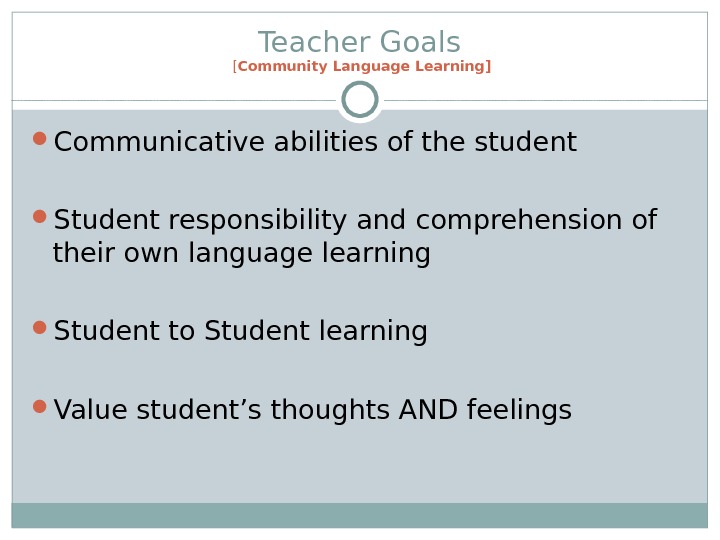






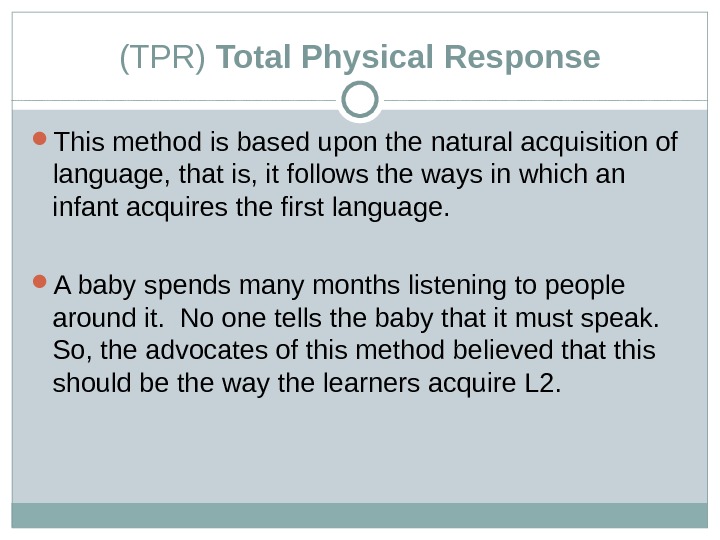
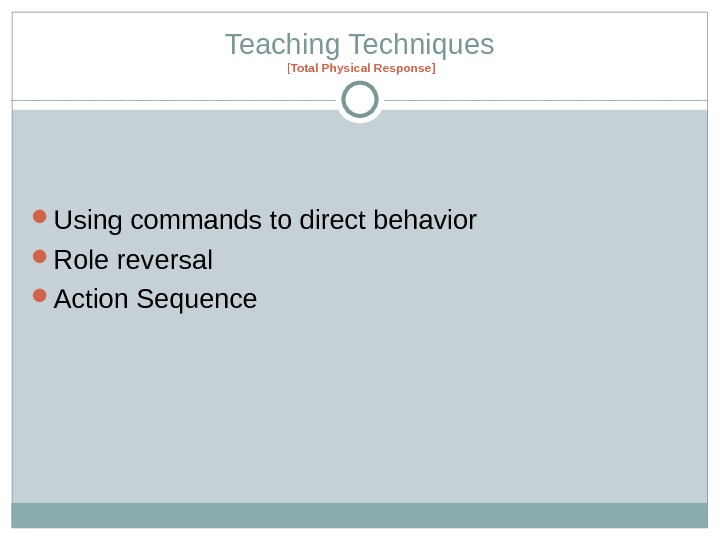

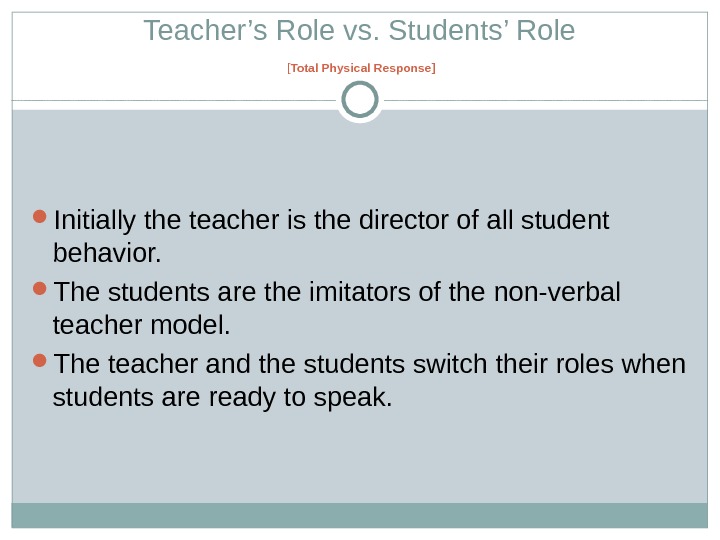




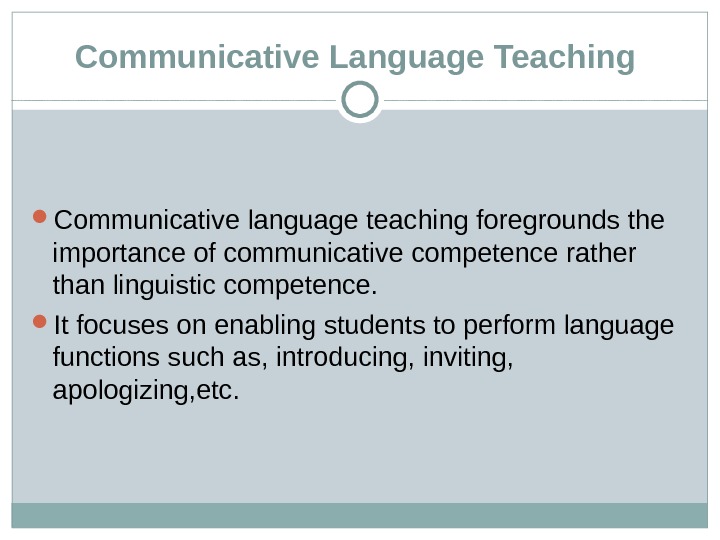

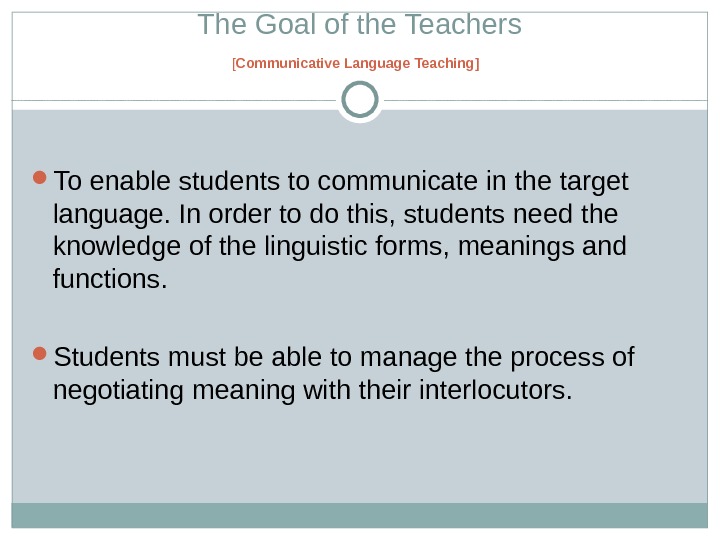



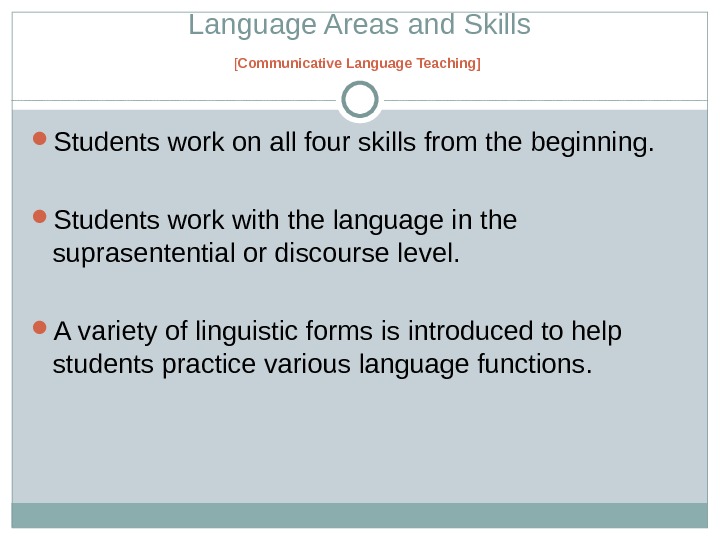
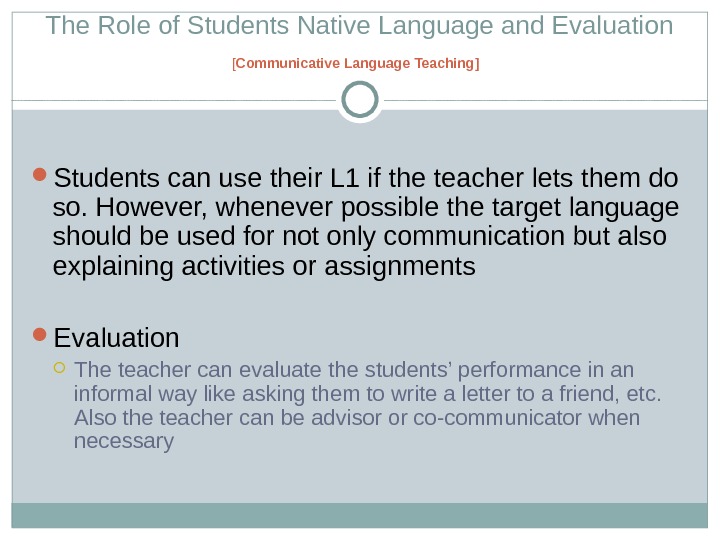

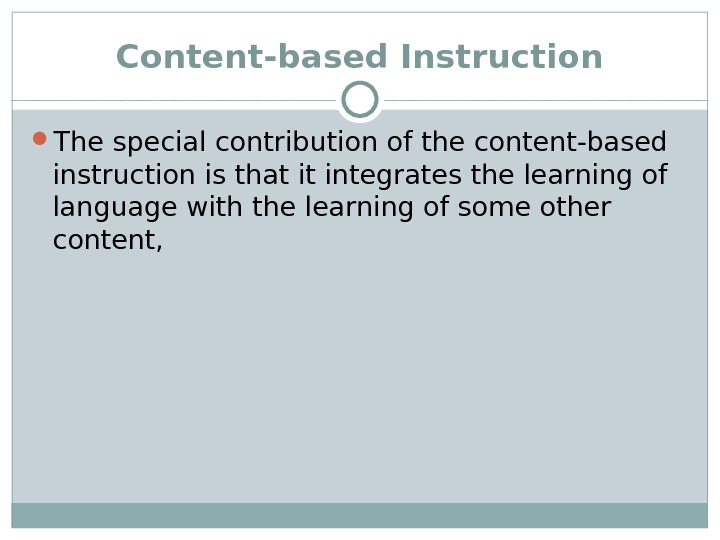
lessons_2-8_methods_of_flt.ppt
- Размер: 1 Mегабайта
- Количество слайдов: 70
Описание презентации Language Teaching Methods Techniques and Principles[FLED 303] Contemporary по слайдам
![Language Teaching Methods Techniques and Principles[FLED 303] Contemporary Methods of Foreign Language Teaching Language Teaching Methods Techniques and Principles[FLED 303] Contemporary Methods of Foreign Language Teaching](/docs//lessons_2-8_methods_of_flt_images/lessons_2-8_methods_of_flt_0.jpg) Language Teaching Methods Techniques and Principles[FLED 303] Contemporary Methods of Foreign Language Teaching
Language Teaching Methods Techniques and Principles[FLED 303] Contemporary Methods of Foreign Language Teaching
 What are we going to cover? Foreign language teaching methods : The Grammar-Translation Method The Direct Method The Audio-Lingual Method The Silent Way Suggestopedia Community Language Learning Total Physical Response Communicative Language Teaching Content-based and Task-based Approaches
What are we going to cover? Foreign language teaching methods : The Grammar-Translation Method The Direct Method The Audio-Lingual Method The Silent Way Suggestopedia Community Language Learning Total Physical Response Communicative Language Teaching Content-based and Task-based Approaches
 The Grammar Translation Method once called “The Classical Method” (Chastain, 1988) Grammar within the context of target language literature The study of the grammar of target language results in becoming better NATIVE language speaker and writer;
The Grammar Translation Method once called “The Classical Method” (Chastain, 1988) Grammar within the context of target language literature The study of the grammar of target language results in becoming better NATIVE language speaker and writer;
 Teaching Techniques ( The Grammar Translation Method) Translation of a literary passage R e ading Comprehension Qu e stions Antonyms/Synonyms Cognates Deductive Application of Rules Fill-in-the-blanks Memorization Use words in Sentences Composition
Teaching Techniques ( The Grammar Translation Method) Translation of a literary passage R e ading Comprehension Qu e stions Antonyms/Synonyms Cognates Deductive Application of Rules Fill-in-the-blanks Memorization Use words in Sentences Composition
 The Goals of the Teachers (The Grammar Translation Method) To be able to read literature written in Target Language To learn grammar rules and vocabulary To develop minds with the study of target language
The Goals of the Teachers (The Grammar Translation Method) To be able to read literature written in Target Language To learn grammar rules and vocabulary To develop minds with the study of target language
 Teacher’s Role vs. Students’ Role (The Grammar Translation Method) Teacher Authoritive Transmitter of Knowledge (Atlas Complex) Students Passive Audience, Receptive Vessels into which Knowledge is poured (Lee, J. & Van. Patten, B. 2003)
Teacher’s Role vs. Students’ Role (The Grammar Translation Method) Teacher Authoritive Transmitter of Knowledge (Atlas Complex) Students Passive Audience, Receptive Vessels into which Knowledge is poured (Lee, J. & Van. Patten, B. 2003)
 Teaching/Learning Process (The Grammar Translation Method) Translation one language to another Deductive Grammar Teaching Grammar Paradigms Memorizing Vocabulary Items
Teaching/Learning Process (The Grammar Translation Method) Translation one language to another Deductive Grammar Teaching Grammar Paradigms Memorizing Vocabulary Items
 The Nature of Interaction in the Classroom (The Grammar Translation Method) ONE WAY: Teacher Students No or Little Interaction among Students
The Nature of Interaction in the Classroom (The Grammar Translation Method) ONE WAY: Teacher Students No or Little Interaction among Students
 Language Areas and Skills (The Grammar Translation Method) Vocabulary and grammar are emphasized. No emphasi s on Pronunciation R e ading and Writing are primary skills Less attention given to Speaking and Listening
Language Areas and Skills (The Grammar Translation Method) Vocabulary and grammar are emphasized. No emphasi s on Pronunciation R e ading and Writing are primary skills Less attention given to Speaking and Listening
 Role of Students’ Native Language and Evaluation (The Grammar Translation Method) Native Language is the primary means of communication. Evaluation; Translation of Written Texts Comprehension Questions
Role of Students’ Native Language and Evaluation (The Grammar Translation Method) Native Language is the primary means of communication. Evaluation; Translation of Written Texts Comprehension Questions
 The Direct Method
The Direct Method
 The Direct Method Like the Grammar-Translation Method, the Direct Method is not new. Since the G-T Method was not effective in preparing students to use the target language communicatively, the Direct Method became popular. The basic rule: No translation allowed. Meaning should be conveyed directly in the L 2.
The Direct Method Like the Grammar-Translation Method, the Direct Method is not new. Since the G-T Method was not effective in preparing students to use the target language communicatively, the Direct Method became popular. The basic rule: No translation allowed. Meaning should be conveyed directly in the L 2.
 Teaching Tec h niques (The Direct Method) Reading aloud Question and Answer exercise Getting students to self-correct Conversation Practice Fill-in-the blank exercise Dictation Map Drawing Paragraph Writing
Teaching Tec h niques (The Direct Method) Reading aloud Question and Answer exercise Getting students to self-correct Conversation Practice Fill-in-the blank exercise Dictation Map Drawing Paragraph Writing
 The Goal of the Teachers (The Direct Method) To teach students how to communicate in the target language. In order to do this successfully , students should learn to think in the target language…
The Goal of the Teachers (The Direct Method) To teach students how to communicate in the target language. In order to do this successfully , students should learn to think in the target language…
 Teacher’s Role vs. Students’ Role (The Direct Method) The teacher directs classroom activities, however, the students’ role is less passive than the one in G-T Method. The teacher and the students are more like partners in the teaching/learning process.
Teacher’s Role vs. Students’ Role (The Direct Method) The teacher directs classroom activities, however, the students’ role is less passive than the one in G-T Method. The teacher and the students are more like partners in the teaching/learning process.
 Teaching/Learning Process (The Direct Method) Meaning should be associated with the target language directly. New target language words or phrases are introduced through the use of realia, pictures, or pantomime. The instructor never translates them into students’ native language. Real situations are created to present a model for everday speech. Grammar is taught inductively.
Teaching/Learning Process (The Direct Method) Meaning should be associated with the target language directly. New target language words or phrases are introduced through the use of realia, pictures, or pantomime. The instructor never translates them into students’ native language. Real situations are created to present a model for everday speech. Grammar is taught inductively.
 The Nature of Interaction in the Classroom (The Direct Method) INTERACTION TEACHER STUDENTSTUDENT
The Nature of Interaction in the Classroom (The Direct Method) INTERACTION TEACHER STUDENTSTUDENT
 Language Areas and Skills (The Direct Method) Vocabulary is emphasized over grammar. Alt h ough work on all four skills (reading, listening, speaking, writing) oc c urs from the start, oral communication is seen as basic. Reading and writing exercises are based upon what students practice orally. Pronunciation also recieves attention right from the beginning of a course
Language Areas and Skills (The Direct Method) Vocabulary is emphasized over grammar. Alt h ough work on all four skills (reading, listening, speaking, writing) oc c urs from the start, oral communication is seen as basic. Reading and writing exercises are based upon what students practice orally. Pronunciation also recieves attention right from the beginning of a course
 Role of Students’ Native Language and Evaluation (The Direct Method) Native language shouldn’t be used in the classroom. Evaluation: Students are asked to use their knowledge about the language by using oral and written skills. (Oral Interviews, Writing a paragraph)
Role of Students’ Native Language and Evaluation (The Direct Method) Native language shouldn’t be used in the classroom. Evaluation: Students are asked to use their knowledge about the language by using oral and written skills. (Oral Interviews, Writing a paragraph)
 The Audio-Lingual Method (Audiolingualism)
The Audio-Lingual Method (Audiolingualism)
 The Audio-Lingual Method Like the Direct Method, it is also an oral-based approach. Drills play a significant role. A strong theoretical base in linguistics and psychology. Native language habits should be overcome and new habit should be formed in the target language
The Audio-Lingual Method Like the Direct Method, it is also an oral-based approach. Drills play a significant role. A strong theoretical base in linguistics and psychology. Native language habits should be overcome and new habit should be formed in the target language
 Teaching Techniques (The Audio-Lingual Method) Dialog Memorization Expansion Drill Repetition Drill Chain Drill Single-Slot Substitution Drill Multiple-Slot Substitution Drill Transformation Drill Use of Minimal Pairs Complete the dialog Grammar Game
Teaching Techniques (The Audio-Lingual Method) Dialog Memorization Expansion Drill Repetition Drill Chain Drill Single-Slot Substitution Drill Multiple-Slot Substitution Drill Transformation Drill Use of Minimal Pairs Complete the dialog Grammar Game
 The Goal of the Teachers (The Audio-Lingual Method) To enable students to use the target language communicatively. In order to do this, students need to overlearn the target language (to learn to use it automatically without stopping to think) Students need to form new habits in L 2 and overcome the old habits of their native language.
The Goal of the Teachers (The Audio-Lingual Method) To enable students to use the target language communicatively. In order to do this, students need to overlearn the target language (to learn to use it automatically without stopping to think) Students need to form new habits in L 2 and overcome the old habits of their native language.
 Teacher’s Role vs. Students’ Role (The Audio-Lingual Method) Teacher = Orchestra Learder, directing and controlling the language behavior of the students. HE/She is also responsible for providing the students with a good model of imitation. Students = Imitators of the teacher’s model. T h ey follow the teacher’s directions and respond as accurately and rapidly as possible.
Teacher’s Role vs. Students’ Role (The Audio-Lingual Method) Teacher = Orchestra Learder, directing and controlling the language behavior of the students. HE/She is also responsible for providing the students with a good model of imitation. Students = Imitators of the teacher’s model. T h ey follow the teacher’s directions and respond as accurately and rapidly as possible.
 Teaching/Learning Process (The Audio-Lingual Method) New vocabulary and structural patterns are presented through dialog ue s. The dialog ue s are learnt through imitation and repetition. Drills are conducted based upon the patterns present in the dialog ues. Grammar is taught inductively. No explicit grammar rule is given.
Teaching/Learning Process (The Audio-Lingual Method) New vocabulary and structural patterns are presented through dialog ue s. The dialog ue s are learnt through imitation and repetition. Drills are conducted based upon the patterns present in the dialog ues. Grammar is taught inductively. No explicit grammar rule is given.
 The Nature of Interaction in the Classroom (The Audio-Lingual Method) INTERACTION TEACHER STUDENTSTUDENT
The Nature of Interaction in the Classroom (The Audio-Lingual Method) INTERACTION TEACHER STUDENTSTUDENT
 Language Areas and Skills (The Audio-Lingual Method) Vocabulary is kept minimum while students are mastering the sound system and grammatical patterns. The natural order of skills presentation is adhered to: listening, speaking, reading, writing. The oral/au ditory skills receive most of the attention. Pronunciation is taught from the beginning.
Language Areas and Skills (The Audio-Lingual Method) Vocabulary is kept minimum while students are mastering the sound system and grammatical patterns. The natural order of skills presentation is adhered to: listening, speaking, reading, writing. The oral/au ditory skills receive most of the attention. Pronunciation is taught from the beginning.
 Role of Students’ Native Language Evaluation Prosedures (The Audio-Lingual Method) The habits of students’ L 1 are t hou ght to interfere with students’ attempts to master L 2. Therefore, L 2 should be used in the classroom. Evaluation: Students might be asked to distinguish betwen words in a minimal pair or to supply an appropriate verb form in a sentence.
Role of Students’ Native Language Evaluation Prosedures (The Audio-Lingual Method) The habits of students’ L 1 are t hou ght to interfere with students’ attempts to master L 2. Therefore, L 2 should be used in the classroom. Evaluation: Students might be asked to distinguish betwen words in a minimal pair or to supply an appropriate verb form in a sentence.
 The Silent Way Derived from the Cognitive Approach Learners seen as actively participative in learning instead of simply receptive. Teaching is aimed at serving the learning process rather than imposing on it. Learners is an internal process which builds upon previous knowledge.
The Silent Way Derived from the Cognitive Approach Learners seen as actively participative in learning instead of simply receptive. Teaching is aimed at serving the learning process rather than imposing on it. Learners is an internal process which builds upon previous knowledge.
 Teaching Techniques & Materials (The Silent Way) Sound-Color Chart Teacher Silence Emphasis on Peer Correction Rods Self-Correction Gestures Word Charts Fidel Charts Structured Feedback
Teaching Techniques & Materials (The Silent Way) Sound-Color Chart Teacher Silence Emphasis on Peer Correction Rods Self-Correction Gestures Word Charts Fidel Charts Structured Feedback
 The Teacher’s Goal (The Silent Way) Students need to use the language for self expression, and need to learn independently (operates under the assumption that learning is an internal process) Teacher instruction is a last resort, the students must become independent by relying on themselves
The Teacher’s Goal (The Silent Way) Students need to use the language for self expression, and need to learn independently (operates under the assumption that learning is an internal process) Teacher instruction is a last resort, the students must become independent by relying on themselves
 The Teacher and Student’s Role (The Silent Way) The teacher does not utter the sounds of the target language, but rather gestures to students how to adapt L 1 sounds to the target language’s sounds. Students are encouraged to be autonomous, Teacher verbal instruction is a last resort. No homework is given, with the assumption that students will assimilate the knowledge naturally over time Peer correction is encouraged “ The teacher works with the student, the student works on the language”
The Teacher and Student’s Role (The Silent Way) The teacher does not utter the sounds of the target language, but rather gestures to students how to adapt L 1 sounds to the target language’s sounds. Students are encouraged to be autonomous, Teacher verbal instruction is a last resort. No homework is given, with the assumption that students will assimilate the knowledge naturally over time Peer correction is encouraged “ The teacher works with the student, the student works on the language”
 Characteristics of the Learning Process (The Silent Way) Students begin learning the language through learning the sounds, with the help of a sound-color chart, and adapting L 1 sounds into the target language’s Teachers structure lessons to focus on the structure of the target language, and intelligible pronunciation Teachers use student errors to find areas to focus on Students practice language structures without drill-like repetition
Characteristics of the Learning Process (The Silent Way) Students begin learning the language through learning the sounds, with the help of a sound-color chart, and adapting L 1 sounds into the target language’s Teachers structure lessons to focus on the structure of the target language, and intelligible pronunciation Teachers use student errors to find areas to focus on Students practice language structures without drill-like repetition
 Classroom Interaction (The Silent Way) The Teacher is mostly silent, but structures instruction to focus on problem areas for students Instruction is predominately non-verbal, consisting of gestures and teaching materials. The teacher speaks to give clues to students, not model the form of the language Student to student interaction is desirable and encouraged
Classroom Interaction (The Silent Way) The Teacher is mostly silent, but structures instruction to focus on problem areas for students Instruction is predominately non-verbal, consisting of gestures and teaching materials. The teacher speaks to give clues to students, not model the form of the language Student to student interaction is desirable and encouraged
 Language Skill Emphasis (The Silent Way) Students practice making target language sounds and native-like pronunciation No linear syllabus, the instructor builds on student knowledge and recycles topics and forms All skills are utilized, but in no particular order
Language Skill Emphasis (The Silent Way) Students practice making target language sounds and native-like pronunciation No linear syllabus, the instructor builds on student knowledge and recycles topics and forms All skills are utilized, but in no particular order
 Role of L 1 and Evaluation Procedures (The Silent Way) L 1 is used to focus student perception and for students to give feedback. Teachers exploit similar sounds in L 1 and target languages to aid student pronunciation No formal evaluation procedures, student evaluation is based on their ability to transfer previous knowledge to new contexts Emphasis on student progress, not perfection
Role of L 1 and Evaluation Procedures (The Silent Way) L 1 is used to focus student perception and for students to give feedback. Teachers exploit similar sounds in L 1 and target languages to aid student pronunciation No formal evaluation procedures, student evaluation is based on their ability to transfer previous knowledge to new contexts Emphasis on student progress, not perfection
 Desuggestopedia Aims to lower psychological barriers to learning to stimulate language learning at an accelerated rate. Class time is structured to remove student performance anxiety. Focused on integration of fine arts into language learning Ideally a unity between the conscious and subconscious will be achieved.
Desuggestopedia Aims to lower psychological barriers to learning to stimulate language learning at an accelerated rate. Class time is structured to remove student performance anxiety. Focused on integration of fine arts into language learning Ideally a unity between the conscious and subconscious will be achieved.
![Teacher Goals [ Desuggestopedia] Accelerate learning for students by lowering psychological barriers. Utilize techniques to Teacher Goals [ Desuggestopedia] Accelerate learning for students by lowering psychological barriers. Utilize techniques to](/docs//lessons_2-8_methods_of_flt_images/lessons_2-8_methods_of_flt_37.jpg) Teacher Goals [ Desuggestopedia] Accelerate learning for students by lowering psychological barriers. Utilize techniques to activate the “paraconscious” area of the mind Paraconscious area is apparently “just below” the conscious area of the mind.
Teacher Goals [ Desuggestopedia] Accelerate learning for students by lowering psychological barriers. Utilize techniques to activate the “paraconscious” area of the mind Paraconscious area is apparently “just below” the conscious area of the mind.
![Teacher and Student Roles [ Desuggestopedia] The teacher is the classroom authority. If the Teacher and Student Roles [ Desuggestopedia] The teacher is the classroom authority. If the](/docs//lessons_2-8_methods_of_flt_images/lessons_2-8_methods_of_flt_38.jpg) Teacher and Student Roles [ Desuggestopedia] The teacher is the classroom authority. If the teacher is respected, the students will be more prone to desuggesting their barriers Secure students that trust the instructor promote spontaneity
Teacher and Student Roles [ Desuggestopedia] The teacher is the classroom authority. If the teacher is respected, the students will be more prone to desuggesting their barriers Secure students that trust the instructor promote spontaneity
![The Learning Process [ Desuggestopedia] Bright and vibrant posters containing grammatical information are hung around the The Learning Process [ Desuggestopedia] Bright and vibrant posters containing grammatical information are hung around the](/docs//lessons_2-8_methods_of_flt_images/lessons_2-8_methods_of_flt_39.jpg) The Learning Process [ Desuggestopedia] Bright and vibrant posters containing grammatical information are hung around the room and changed every few weeks Students assume target language identities Students work with lengthy target language dialogs alongside L 1 translations and glossing material The instructor reads the dialog while syncopating their voice to music Students follow along The instructor reads at a normal pace Students read the dialog that evening before bed and in the morning Students perform dramatization activities etc. the next meeting
The Learning Process [ Desuggestopedia] Bright and vibrant posters containing grammatical information are hung around the room and changed every few weeks Students assume target language identities Students work with lengthy target language dialogs alongside L 1 translations and glossing material The instructor reads the dialog while syncopating their voice to music Students follow along The instructor reads at a normal pace Students read the dialog that evening before bed and in the morning Students perform dramatization activities etc. the next meeting
![Classroom Interaction [ Desuggestopedia] The instructor initiates interaction with the group and individuals Later, students will Classroom Interaction [ Desuggestopedia] The instructor initiates interaction with the group and individuals Later, students will](/docs//lessons_2-8_methods_of_flt_images/lessons_2-8_methods_of_flt_40.jpg) Classroom Interaction [ Desuggestopedia] The instructor initiates interaction with the group and individuals Later, students will be able to respond in target language, eventually initiating interaction
Classroom Interaction [ Desuggestopedia] The instructor initiates interaction with the group and individuals Later, students will be able to respond in target language, eventually initiating interaction
![Views on Language and Culture [ Desuggestopedia] Language is the first plane on a two Views on Language and Culture [ Desuggestopedia] Language is the first plane on a two](/docs//lessons_2-8_methods_of_flt_images/lessons_2-8_methods_of_flt_41.jpg) Views on Language and Culture [ Desuggestopedia] Language is the first plane on a two plane process of communication Nonverbal context is the second plane Fine arts are emphasized
Views on Language and Culture [ Desuggestopedia] Language is the first plane on a two plane process of communication Nonverbal context is the second plane Fine arts are emphasized
![Language Skills Emphasized [ Desuggestopedia] Vocabulary is emphasized Grammar is dealt with explicitly, but sparingly Students Language Skills Emphasized [ Desuggestopedia] Vocabulary is emphasized Grammar is dealt with explicitly, but sparingly Students](/docs//lessons_2-8_methods_of_flt_images/lessons_2-8_methods_of_flt_42.jpg) Language Skills Emphasized [ Desuggestopedia] Vocabulary is emphasized Grammar is dealt with explicitly, but sparingly Students read dialogs in the target language Students write imaginative dialogs Emphasis is on communicative speaking
Language Skills Emphasized [ Desuggestopedia] Vocabulary is emphasized Grammar is dealt with explicitly, but sparingly Students read dialogs in the target language Students write imaginative dialogs Emphasis is on communicative speaking
![Role of L 1 and Evaluation [ Desuggestopedia] L 1 is used to make meaning clear Role of L 1 and Evaluation [ Desuggestopedia] L 1 is used to make meaning clear](/docs//lessons_2-8_methods_of_flt_images/lessons_2-8_methods_of_flt_43.jpg) Role of L 1 and Evaluation [ Desuggestopedia] L 1 is used to make meaning clear L 1 is phased out of the classroom over time Evaluation is assessed through in class performance, but not through formal procedures
Role of L 1 and Evaluation [ Desuggestopedia] L 1 is used to make meaning clear L 1 is phased out of the classroom over time Evaluation is assessed through in class performance, but not through formal procedures
 Community Language Learning Another humanistic psychology learning method Focuses on teacher-counselor role Teacher focuses on understanding student struggles
Community Language Learning Another humanistic psychology learning method Focuses on teacher-counselor role Teacher focuses on understanding student struggles
![Teacher Goals [ Community Language Learning] Communicative abilities of the student Student responsibility and comprehension of Teacher Goals [ Community Language Learning] Communicative abilities of the student Student responsibility and comprehension of](/docs//lessons_2-8_methods_of_flt_images/lessons_2-8_methods_of_flt_45.jpg) Teacher Goals [ Community Language Learning] Communicative abilities of the student Student responsibility and comprehension of their own language learning Student to Student learning Value student’s thoughts AND feelings
Teacher Goals [ Community Language Learning] Communicative abilities of the student Student responsibility and comprehension of their own language learning Student to Student learning Value student’s thoughts AND feelings
![Role of Teachers and Students [ Community Language Learning] Teacher is primarily a counselor Understands student Role of Teachers and Students [ Community Language Learning] Teacher is primarily a counselor Understands student](/docs//lessons_2-8_methods_of_flt_images/lessons_2-8_methods_of_flt_46.jpg) Role of Teachers and Students [ Community Language Learning] Teacher is primarily a counselor Understands student struggles and supports student learning Teacher slowly shifts focus from supporting students to accuracy
Role of Teachers and Students [ Community Language Learning] Teacher is primarily a counselor Understands student struggles and supports student learning Teacher slowly shifts focus from supporting students to accuracy
![Learning Process Characteristics [ Community Language Learning] Students have conversations in L 1, then the teacher Learning Process Characteristics [ Community Language Learning] Students have conversations in L 1, then the teacher](/docs//lessons_2-8_methods_of_flt_images/lessons_2-8_methods_of_flt_47.jpg) Learning Process Characteristics [ Community Language Learning] Students have conversations in L 1, then the teacher interjects “chunk’s” of the target language The conversation is recorded and transcribed, to become material for later classes Grammar points are examined Students tell teacher how they feel Teacher understands Six elements to non-defensive learning Security Aggression Attention Reflection Retention Discrimination
Learning Process Characteristics [ Community Language Learning] Students have conversations in L 1, then the teacher interjects “chunk’s” of the target language The conversation is recorded and transcribed, to become material for later classes Grammar points are examined Students tell teacher how they feel Teacher understands Six elements to non-defensive learning Security Aggression Attention Reflection Retention Discrimination
![Nature of Classroom Interaction [ Community Language Learning] Teacher to student interaction is dynamic. Sometimes Nature of Classroom Interaction [ Community Language Learning] Teacher to student interaction is dynamic. Sometimes](/docs//lessons_2-8_methods_of_flt_images/lessons_2-8_methods_of_flt_48.jpg) Nature of Classroom Interaction [ Community Language Learning] Teacher to student interaction is dynamic. Sometimes the teacher facilitates students expression Other times students are assertive And still other cases the teacher instructs the class Over time the students are more and more involved in their instruction Students work in a cooperative manner
Nature of Classroom Interaction [ Community Language Learning] Teacher to student interaction is dynamic. Sometimes the teacher facilitates students expression Other times students are assertive And still other cases the teacher instructs the class Over time the students are more and more involved in their instruction Students work in a cooperative manner
![L 1 and Cultural Views [ Community Language Learning] Language is for communication (Curran) Initially students L 1 and Cultural Views [ Community Language Learning] Language is for communication (Curran) Initially students](/docs//lessons_2-8_methods_of_flt_images/lessons_2-8_methods_of_flt_49.jpg) L 1 and Cultural Views [ Community Language Learning] Language is for communication (Curran) Initially students try to create a group identity through language tasks Later, the focus shifts to the target language Culture is viewed as an integral part of language learning
L 1 and Cultural Views [ Community Language Learning] Language is for communication (Curran) Initially students try to create a group identity through language tasks Later, the focus shifts to the target language Culture is viewed as an integral part of language learning
![Areas and Skills of Language Emphasized [ Community Language Learning] Students develop material to reflect what Areas and Skills of Language Emphasized [ Community Language Learning] Students develop material to reflect what](/docs//lessons_2-8_methods_of_flt_images/lessons_2-8_methods_of_flt_50.jpg) Areas and Skills of Language Emphasized [ Community Language Learning] Students develop material to reflect what they want to learn in the target language When students feel more secure the teacher may use textbooks Particular language points are picked out of students material Comprehension and speaking of target language is the primary goal Reinforcement of language learning through reading and writing
Areas and Skills of Language Emphasized [ Community Language Learning] Students develop material to reflect what they want to learn in the target language When students feel more secure the teacher may use textbooks Particular language points are picked out of students material Comprehension and speaking of target language is the primary goal Reinforcement of language learning through reading and writing
![L 1 Usage and Evaluation Procedures [ Community Language Learning] Literal translations and cognates from L L 1 Usage and Evaluation Procedures [ Community Language Learning] Literal translations and cognates from L](/docs//lessons_2-8_methods_of_flt_images/lessons_2-8_methods_of_flt_51.jpg) L 1 Usage and Evaluation Procedures [ Community Language Learning] Literal translations and cognates from L 1 to target languages are used as much as possible Students may express their feelings in L 1 If there are multiple L 1’s, target language conversations are utilized from the beginning of the course No concrete evaluation procedures Teacher made classroom tests are ideal
L 1 Usage and Evaluation Procedures [ Community Language Learning] Literal translations and cognates from L 1 to target languages are used as much as possible Students may express their feelings in L 1 If there are multiple L 1’s, target language conversations are utilized from the beginning of the course No concrete evaluation procedures Teacher made classroom tests are ideal
 (TPR) Total Physical Response This method is based upon the natural acquisition of language, that is, it follows the ways in which an infant acquires the first language. A baby spends many months listening to people around it. No one tells the baby that it must speak. So, the advocates of this method believed that this should be the way the learners acquire L 2.
(TPR) Total Physical Response This method is based upon the natural acquisition of language, that is, it follows the ways in which an infant acquires the first language. A baby spends many months listening to people around it. No one tells the baby that it must speak. So, the advocates of this method believed that this should be the way the learners acquire L 2.
![Teaching Techniques [ Total Physical Response ] Using commands to direct behavior Role reversal Action Sequence Teaching Techniques [ Total Physical Response ] Using commands to direct behavior Role reversal Action Sequence](/docs//lessons_2-8_methods_of_flt_images/lessons_2-8_methods_of_flt_53.jpg) Teaching Techniques [ Total Physical Response ] Using commands to direct behavior Role reversal Action Sequence
Teaching Techniques [ Total Physical Response ] Using commands to direct behavior Role reversal Action Sequence
![The Goal of Teachers [ Total Physical Response ] This method aims at stress-free learning The Goal of Teachers [ Total Physical Response ] This method aims at stress-free learning](/docs//lessons_2-8_methods_of_flt_images/lessons_2-8_methods_of_flt_54.jpg) The Goal of Teachers [ Total Physical Response ] This method aims at stress-free learning environment for students. The teacher encourages the students to persist in their study beyond the beginning level of proficiency.
The Goal of Teachers [ Total Physical Response ] This method aims at stress-free learning environment for students. The teacher encourages the students to persist in their study beyond the beginning level of proficiency.
![Teacher’s Role vs. Students’ Role [ Total Physical Response ] Initially the teacher is the director Teacher’s Role vs. Students’ Role [ Total Physical Response ] Initially the teacher is the director](/docs//lessons_2-8_methods_of_flt_images/lessons_2-8_methods_of_flt_55.jpg) Teacher’s Role vs. Students’ Role [ Total Physical Response ] Initially the teacher is the director of all student behavior. The students are the imitators of the non-verbal teacher model. The teacher and the students switch their roles when students are ready to speak.
Teacher’s Role vs. Students’ Role [ Total Physical Response ] Initially the teacher is the director of all student behavior. The students are the imitators of the non-verbal teacher model. The teacher and the students switch their roles when students are ready to speak.
![Teaching/Learning Process [ Total Physical Response ] First, the teacher issues commands. Next, the students Teaching/Learning Process [ Total Physical Response ] First, the teacher issues commands. Next, the students](/docs//lessons_2-8_methods_of_flt_images/lessons_2-8_methods_of_flt_56.jpg) Teaching/Learning Process [ Total Physical Response ] First, the teacher issues commands. Next, the students act the commands to show their understanding. After learning to respond to some aural commands, they learn how to read and write them.
Teaching/Learning Process [ Total Physical Response ] First, the teacher issues commands. Next, the students act the commands to show their understanding. After learning to respond to some aural commands, they learn how to read and write them.
![The Nature of Interaction in the Classroom [ Total Physical Response ] Initially the interaction is The Nature of Interaction in the Classroom [ Total Physical Response ] Initially the interaction is](/docs//lessons_2-8_methods_of_flt_images/lessons_2-8_methods_of_flt_57.jpg) The Nature of Interaction in the Classroom [ Total Physical Response ] Initially the interaction is characterised by the teacher speaking and the students responding nonverbally. Later on, students become more verbal and the teacher responds nonverbally.
The Nature of Interaction in the Classroom [ Total Physical Response ] Initially the interaction is characterised by the teacher speaking and the students responding nonverbally. Later on, students become more verbal and the teacher responds nonverbally.
![Language Skills and Areas [ Total Physical Response ] Vocabulary and grammatical structures are embedded Language Skills and Areas [ Total Physical Response ] Vocabulary and grammatical structures are embedded](/docs//lessons_2-8_methods_of_flt_images/lessons_2-8_methods_of_flt_58.jpg) Language Skills and Areas [ Total Physical Response ] Vocabulary and grammatical structures are embedded within imperatives. The reason for the use of imperatives is the frequen t occurrence of it in the language directed at young children. Spoken language is emphasized over written language.
Language Skills and Areas [ Total Physical Response ] Vocabulary and grammatical structures are embedded within imperatives. The reason for the use of imperatives is the frequen t occurrence of it in the language directed at young children. Spoken language is emphasized over written language.
![The role of Student’s Native Language and Evaluation [ Total Physical Response ] TPR is usually The role of Student’s Native Language and Evaluation [ Total Physical Response ] TPR is usually](/docs//lessons_2-8_methods_of_flt_images/lessons_2-8_methods_of_flt_59.jpg) The role of Student’s Native Language and Evaluation [ Total Physical Response ] TPR is usually introduced in L 1. After the introduction, the native language is rarely used. Meaning is made clear through body movements. Formal evaluations can simply be conducted by asking t he student s to perform a series of commands. For advanced learners, the evaluation can be made through skids.
The role of Student’s Native Language and Evaluation [ Total Physical Response ] TPR is usually introduced in L 1. After the introduction, the native language is rarely used. Meaning is made clear through body movements. Formal evaluations can simply be conducted by asking t he student s to perform a series of commands. For advanced learners, the evaluation can be made through skids.
 Communicative Language Teaching Communicative language teaching foregrounds the importance of communicative competence rather than linguistic competence. It focuses on enabling students to perform language functions such as, introducing, inviting, apologizing, etc.
Communicative Language Teaching Communicative language teaching foregrounds the importance of communicative competence rather than linguistic competence. It focuses on enabling students to perform language functions such as, introducing, inviting, apologizing, etc.
![Teaching Techniques [ Communicative Language Teaching ] Authentic Materials Scrambled Sentences Language Games Picture Teaching Techniques [ Communicative Language Teaching ] Authentic Materials Scrambled Sentences Language Games Picture](/docs//lessons_2-8_methods_of_flt_images/lessons_2-8_methods_of_flt_61.jpg) Teaching Techniques [ Communicative Language Teaching ] Authentic Materials Scrambled Sentences Language Games Picture Strip Story Role Play
Teaching Techniques [ Communicative Language Teaching ] Authentic Materials Scrambled Sentences Language Games Picture Strip Story Role Play
![The Goal of the Teachers [ Communicative Language Teaching ] To enable students to communicate The Goal of the Teachers [ Communicative Language Teaching ] To enable students to communicate](/docs//lessons_2-8_methods_of_flt_images/lessons_2-8_methods_of_flt_62.jpg) The Goal of the Teachers [ Communicative Language Teaching ] To enable students to communicate in the target language. In order to do this, students need the knowledge of the linguistic forms, meanings and functions. Students must be able to manage the process of negotiating meaning with their interlocutors.
The Goal of the Teachers [ Communicative Language Teaching ] To enable students to communicate in the target language. In order to do this, students need the knowledge of the linguistic forms, meanings and functions. Students must be able to manage the process of negotiating meaning with their interlocutors.
![The Role of the Teacher and the Students [ Communicative Language Teaching ] The teacher The Role of the Teacher and the Students [ Communicative Language Teaching ] The teacher](/docs//lessons_2-8_methods_of_flt_images/lessons_2-8_methods_of_flt_63.jpg) The Role of the Teacher and the Students [ Communicative Language Teaching ] The teacher acts like an advisor facilitating communication in the classroom. He is supposed to establish situations likely to promote communication. Students are communicators. They are actively engaged in negotiating meaning even when their knowledge is incomplete.
The Role of the Teacher and the Students [ Communicative Language Teaching ] The teacher acts like an advisor facilitating communication in the classroom. He is supposed to establish situations likely to promote communication. Students are communicators. They are actively engaged in negotiating meaning even when their knowledge is incomplete.
![Teaching/Learning Process [ Communicative Language Teaching ] Almost everyt hi ng that is done with Teaching/Learning Process [ Communicative Language Teaching ] Almost everyt hi ng that is done with](/docs//lessons_2-8_methods_of_flt_images/lessons_2-8_methods_of_flt_64.jpg) Teaching/Learning Process [ Communicative Language Teaching ] Almost everyt hi ng that is done with communicative intent. Students use the language a great deal through communicative activites such as games, role plays, and problem solving tasks. In each activity, there is an information gap, which leads students to exchange new information. True communication is purposeful. The materials used during the activities are authentic.
Teaching/Learning Process [ Communicative Language Teaching ] Almost everyt hi ng that is done with communicative intent. Students use the language a great deal through communicative activites such as games, role plays, and problem solving tasks. In each activity, there is an information gap, which leads students to exchange new information. True communication is purposeful. The materials used during the activities are authentic.
![The Nature of Interaction in the Classroom [ Communicative Language Teaching ] INTERACTION Teacher The Nature of Interaction in the Classroom [ Communicative Language Teaching ] INTERACTION Teacher](/docs//lessons_2-8_methods_of_flt_images/lessons_2-8_methods_of_flt_65.jpg) The Nature of Interaction in the Classroom [ Communicative Language Teaching ] INTERACTION Teacher Students Students
The Nature of Interaction in the Classroom [ Communicative Language Teaching ] INTERACTION Teacher Students Students
![Language Areas and Skills [ Communicative Language Teaching ] Students work on all four skills Language Areas and Skills [ Communicative Language Teaching ] Students work on all four skills](/docs//lessons_2-8_methods_of_flt_images/lessons_2-8_methods_of_flt_66.jpg) Language Areas and Skills [ Communicative Language Teaching ] Students work on all four skills from the beginning. Students work with the language in the suprasentential or discourse level. A variety of linguistic forms is introduced to help students practice various language functions.
Language Areas and Skills [ Communicative Language Teaching ] Students work on all four skills from the beginning. Students work with the language in the suprasentential or discourse level. A variety of linguistic forms is introduced to help students practice various language functions.
![The Role of Students Native Language and Evaluation [ Communicative Language Teaching ] Students can The Role of Students Native Language and Evaluation [ Communicative Language Teaching ] Students can](/docs//lessons_2-8_methods_of_flt_images/lessons_2-8_methods_of_flt_67.jpg) The Role of Students Native Language and Evaluation [ Communicative Language Teaching ] Students can use their L 1 if the teacher lets them do so. However, whenever possible the target language should be used for not only communication but also explaining activities or assignments Evaluation The teacher can evaluate the students’ performance in an informal way like asking them to write a letter to a friend, etc. Also the teacher can be advisor or co-communicator when necessary
The Role of Students Native Language and Evaluation [ Communicative Language Teaching ] Students can use their L 1 if the teacher lets them do so. However, whenever possible the target language should be used for not only communication but also explaining activities or assignments Evaluation The teacher can evaluate the students’ performance in an informal way like asking them to write a letter to a friend, etc. Also the teacher can be advisor or co-communicator when necessary
 Content-based, Task-based, and Participatory Approaches The point where these three approaches meet is that they all make the communication central as is the case in CLT. These approaches focus on ‘using English to learn it’ rather than ‘learning English to use it’
Content-based, Task-based, and Participatory Approaches The point where these three approaches meet is that they all make the communication central as is the case in CLT. These approaches focus on ‘using English to learn it’ rather than ‘learning English to use it’
 Content-based Instruction The special contribution of the content-based instruction is that it integrates the learning of language with the learning of some other content,
Content-based Instruction The special contribution of the content-based instruction is that it integrates the learning of language with the learning of some other content,

